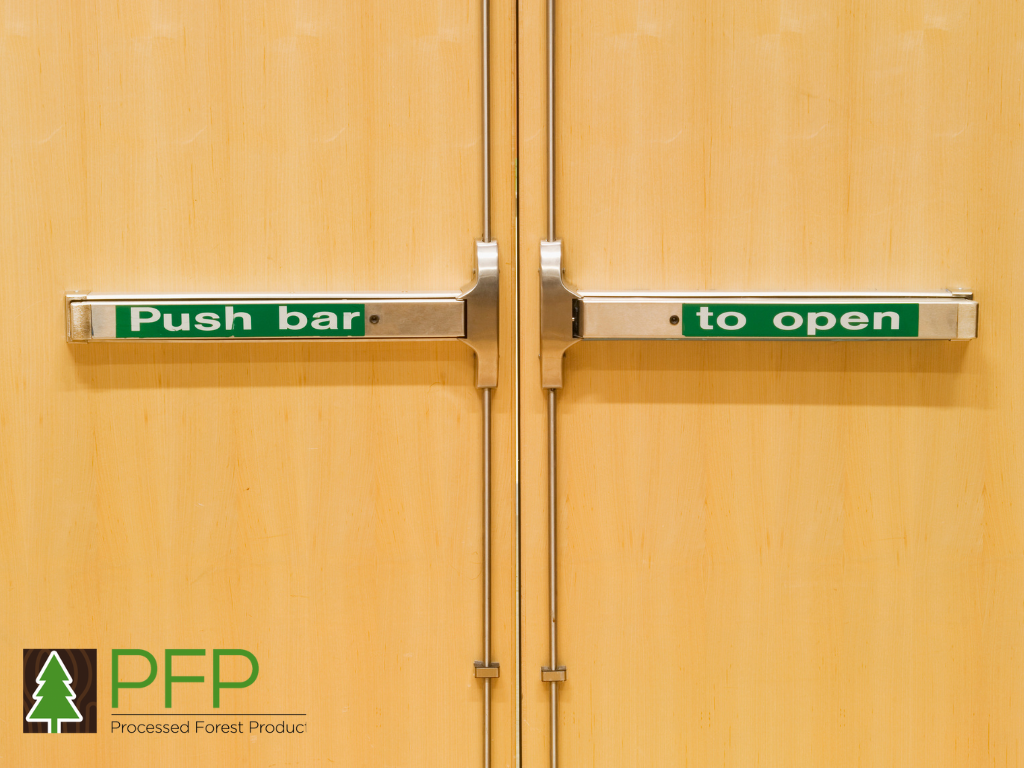[joli-toc]
Fire rated doors play a crucial role in fire safety by acting as a barrier to slow the spread of fire and smoke between different sections of a building. These specialized doors are constructed to withstand fire for a specified period, typically ranging from 20 minutes to over an hour. This containment provides critical time for occupants to safely evacuate and for emergency services to respond, significantly reducing the risk of fatalities and property damage.
The Basic Mechanism of Fire Rated Doors
The basic mechanism of fire rated doors involves the use of fire-resistant materials in their construction, such as steel, gypsum, and vermiculite boards. These materials are capable of withstanding high temperatures. The doors are also fitted with seals that expand in heat, closing gaps to prevent smoke and fire from passing through. Fire rated doors are often equipped with automatic closing systems to ensure they remain shut during a fire, as an open fire rated door will not serve its protective purpose.
Role of Fire Rated Doors in Ensuring Safety
How Fire Rated Doors Contribute to Containing Fires
Fire rated doors are an integral part of a building’s passive fire protection system. By compartmentalizing fire, they prevent or slow the spread of fire and smoke, which can be crucial in saving lives and property. This containment allows for safe egress routes for occupants and helps in localizing the fire, making it easier for firefighters to extinguish it. By maintaining the integrity of escape routes, fire rated doors ensure that people can evacuate safely.
The Importance of Fire Rated Doors in Evacuation Protocols
In evacuation protocols, fire rated doors provide vital protection in corridors, stairwells, and other areas designated as escape routes. They are strategically placed to create a safe and smoke-free path for evacuation. Their presence is especially important in high-rise buildings, healthcare facilities, and schools, where evacuation can take more time and the safety of vulnerable individuals is paramount.
Standards and Regulations for Fire Rated Doors

Overview of National and International Safety Standards
Fire rated doors must adhere to stringent safety standards that vary by country and region. Internationally recognized standards, such as those set by the National Fire Protection Association (NFPA) or the International Building Code (IBC), specify the minimum requirements for fire resistance, materials, and installation of these doors. These standards ensure a uniform level of safety and performance in fire emergencies.
Compliance Requirements for Different Types of Buildings
The compliance requirements for fire rated doors can differ based on the building’s type, size, and purpose. For example, commercial and public buildings often have stricter regulations compared to residential buildings. The requirements specify the fire rating needed, which depends on factors like the building’s layout, the potential fire load, and the evacuation time. Regular inspections and maintenance are also mandated to ensure that these doors function correctly over time.
Fire Rated Doors in Emergency Situations
How Fire Rated Doors Function During a Fire
During a fire, fire rated doors function as a critical barrier against the spread of flames and smoke. These doors are designed to automatically close in the event of a fire, which is often achieved through the use of fusible links or electromagnetic devices that release when triggered by high temperatures. Once closed, the fire resistant materials and construction of the door work to contain the fire to a specific compartment or area, significantly slowing its spread. This containment is crucial for protecting escape routes and providing additional time for occupants to evacuate safely.
Effectiveness of Fire Rated Doors
The effectiveness of fire rated doors in emergency situations has been proven in numerous instances. For example, in a building fire, a closed fire rated door can contain flames and smoke within a single room, preventing the fire from engulfing an entire floor or building. This containment not only saves lives but also minimizes property damage, allowing firefighters to tackle the fire more effectively.
Integration of Fire Rated Doors in Building Design

Incorporating Fire Rated Doors in Architectural Planning
Incorporating fire rated doors into the architectural planning of a building is a critical aspect of fire safety design. Architects and planners must identify key locations where these doors are most needed, such as stairwells, corridors, and rooms with high fire risk. The placement of these doors is strategically planned to maximize their effectiveness in containing fires and facilitating safe evacuation routes.
Balancing Aesthetic and Functional Aspects
While the primary function of fire rated doors is safety, modern advancements have made it possible to integrate these doors into building designs without compromising aesthetics. Today, fire rated doors come in various styles and finishes that can complement the interior design of a building. Designers can choose from a range of materials, colors, and finishes to ensure that these safety features blend seamlessly with the overall architectural aesthetic.
Understanding Fire Ratings and Door Specifications
Deciphering Fire Door Ratings and What They Mean
Fire door ratings, typically expressed in minutes (e.g., 30, 60, 90, 120), indicate the duration for which a door can withstand fire exposure. These ratings are determined through standardized testing and indicate how long a door can contain a fire while maintaining its structural integrity. For instance, a 60-minute fire rated door is designed to withstand fire for up to one hour.
Specifications and Features of Various Fire Rated Doors
Various specifications and features characterize different fire rated doors. These may include the type of core material used (such as steel, wood, or gypsum), the presence of fire and smoke seals, the type of glass used in doors with windows, and the door’s hardware like hinges, handles, and locking mechanisms. The specific requirements of a fire rated door will depend on its intended use, location, and the fire safety regulations applicable to the building.
Challenges in Implementing Fire Rated Doors
Common Obstacles in the Installation and Use of Fire Rated Doors
Implementing fire rated doors can come with a set of challenges. One common obstacle is the cost, as these doors are typically more expensive than standard doors due to their specialized materials and construction. Another challenge is ensuring proper installation – if not correctly installed, the door’s fire-resisting capabilities may be compromised. In some older buildings, retrofitting fire rated doors can be difficult due to space limitations or structural constraints. Additionally, maintaining the functionality of these doors over time, especially in high-traffic areas where they may be subject to wear and tear, can be challenging.
Solutions to Overcome These Challenges
To overcome these challenges, it’s important to prioritize fire rated doors in the building’s safety budget. Professional installation by certified technicians is crucial to ensure the doors function as intended. For retrofitting in older buildings, customized solutions may be needed to fit the specific dimensions and structural conditions. Regular maintenance and inspections by qualified personnel can help preserve the integrity and functionality of fire rated doors.
Awareness and Education on Fire Rated Doors
Importance of Educating Building Occupants About Fire Rated Doors
Educating building occupants about fire rated doors is essential for ensuring these safety features are effectively utilized. Occupants need to understand the purpose of these doors and the importance of keeping them closed to prevent the spread of fire and smoke. Awareness of how to operate these doors during an emergency is also crucial for safe evacuation.
Effective Ways to Spread Awareness and Train Occupants
To spread awareness and train occupants, informational sessions or drills that include specific guidance on fire rated doors can be conducted. Signage can be placed on or near the doors to remind occupants of their importance and proper use. Regular fire drills that incorporate the use of fire rated doors can also reinforce this training. Additionally, including information on fire rated doors in the building’s safety manuals or orientation materials for new occupants can be an effective strategy.
Conclusion
The effectiveness of fire rated doors depends on continued compliance with safety standards and ongoing awareness among building occupants and management. Regular inspections, maintenance, and adherence to installation guidelines are imperative to ensure these doors function as intended. Equally important is the continuous education and training of everyone who uses the building, ensuring they understand the critical role these doors play in fire safety. Emphasizing the importance of fire rated doors is a commitment to overall safety and wellbeing within any building.

